One of ten early career journalists to have received the Middlebury College Fellowships in Environmental Journalism this year, Sarah Harris ’11 plans to “tell the story of cement” through the mediums of print and radio.
Harris will spend her J-term semester and part of December in Midlothian, Texas – roughly 25 miles southwest of Dallas – and Kansas reporting on the issue of cement production using the $4,000 granted to her by the College.
“I first learned that there’d been a cement plant in southwest Dallas, and then I started learning that there were actually cement plants all over Dallas and that this community of Midlothian had three of them … It grew into this really interesting story that I wanted to pursue,” said Harris, a Texas native.
Harris furthered her interest in the Midlothian cement plants after learning about the scandals that had taken place there in the late ’80s and early ’90s.
“What happened in Midlothian was that the cement companies had been burning hazardous wastes in their kilns and turning a huge profit from it [as] it was cheaper,” Harris said. “They didn’t apply for a permit or go through the channels they were supposed to [in order to] dispose of hazardous waste properly, and it went completely unchecked.”
Fellowship applicants were required to send in two-to-three-page pitches outlining their stories as well as their plans of research.
“I’ll go through public records; I’ll interview people; I’ll use the contacts I have to get in touch with community activists … people who have worked with plants, regular everyday citizens, people in the cement industry, people with knowledge of the cement industry, [and] people who are working on ideas of green cement,” said Harris. “That’s how I’ll gather information on the ground in those communities.”
Based on data compiled by the Canadian non-profit organization EcoSmart Concrete, cement production accounts for seven to eight percent of carbon dioxide emissions globally.
“[Cement production] hasn’t gathered [enough] attention from environmentalists and the media,” she said. “It produces a lot of mercury and dioxin which can get into water supplies, which can [also] affect air quality.”
Having already accumulated experience producing stories for North Country Public Radio, a station based in Canton, New York, Harris hopes to use this fellowship as a means to break into print journalism.
“I think it’s a really exciting field to be getting into,” she said. “I certainly think [environmental journalism] has a place in our world. I’ve always really enjoyed writing and reading, and I’ve always wanted to figure out how I could make writing really work for me.”
Harris and the nine other recipients of the Middlebury College Environmental Fellowship are scheduled to meet twice a year: in California at the Monterey Institute of International Studies in the spring and on the Middlebury campus itself during the fall. Her finished project will be a 3,000-word print story in addition to a radio narrative of four minutes length, both of which she will pitch to local media outlets in Texas.
“I’m really interested in nonfiction,” said Harris. “I’m interested in journalism as a way in which to put relevant information into the world and a way in which to process the way we see our world. I think environmental journalism is enormously, enormously relevant.”
Harris pursues reporting on cement
Comments



